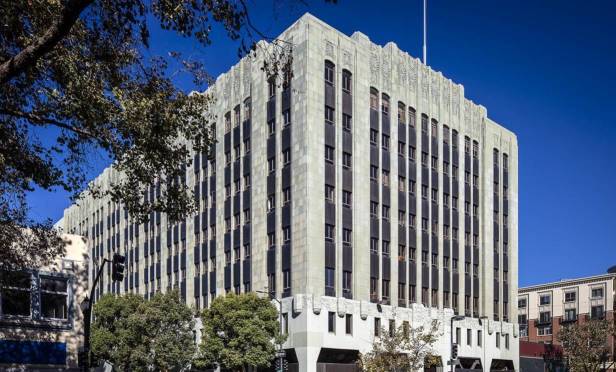 With large floor plates and high ceilings, the building is well-suited for creative, tech and start-ups.
With large floor plates and high ceilings, the building is well-suited for creative, tech and start-ups.
OAKLAND, CA—Built in 1931, the iconic Art Deco-designed Breuner Building at 2201 Broadway was originally designed by famed architect Albert Roller as the home of Breuner's Home Furnishings. It was converted to office space some 20 years ago but languished over time.
Today, the one-of-a-kind structure has once again come to life in the Uptown area. TMG Partners purchased the building about seven years ago and completed extensive renovations including a facade upgrade, blade signage, fully reimagined lobby and common area, amenity upgrades, a new roof, and complete HVAC, elevator and fire life safety modernization.
With that revitalization beckoning tenants, co-working behemoth WeWork leased three full floors of approximately 68,000 square feet. WeWork will occupy the office space in two phases with phase I commencing immediately and phase II commencing in January 2020. The large floor plates offered in the building provide contiguous spaces that creative tenants are seeking, GlobeSt.com learns.
“The iconic Art Deco-designed Breuner Building, now fully restored and renovated, is a very attractive draw for tenants such as WeWork who want an environment that combines true architectural authenticity with modern design and technology,” said David Cropper, TMG Partners director of development. “With large floor plates and high ceilings, the property is ideally suited for creative, technology and other start-up tenants–not to mention our location within two blocks of BART, Lake Merritt, and a myriad of restaurants and entertainment venues.”
Clad in green terra cotta tiling, Art Deco styling and motifs depicting furniture craftsmen adorn the building's southern and eastern elevations. The building's northern facade has also served as “The Great Wall of Oakland,” a 100 by 100-foot installation which provides an ideal backdrop for film screenings and vertical dance troupe performances, playing a central role in the Uptown neighborhood's cultural resurgence.
“We refurbished the terra cotta skin, along with the other upgrades we completed,” Cropper tells GlobeSt.com. “We've brought the building into the 21st Century without ignoring its history and great bones.”
Cushman and Wakefield's John Dolby and Dane Hooks lead all leasing efforts for the building. Savills Studley's Steve Barker advised tenant WeWork.
This is the second building purchased and renovated by TMG. The other building at 1330 Broadway also underwent upgrades as part of TMG's acquisition process.
“We think Oakland is a fantastic investment opportunity,” Cropper tells GlobeSt.com.
Indeed, Oakland is the beneficiary of a good number of users such as the creative office types going into Uptown. And, others are relocating from San Francisco to Oakland. For example, Blue Shield of California recently announced that it will decamp more than 1,000 employees to Oakland, GlobeSt.com learns.
Co-working space providers are also adding to the competition for larger blocks of space throughout the Bay Area, according to Savills Studley's third quarter office report. In its struggle to keep up with WeWork's expansion, Spaces, Regus' co-working division, leased 77,999 square feet at the Bank of America complex at 345 Montgomery St. in San Francisco.
WeWork recently introduced HQ by WeWork, its new division for midsized companies that focuses on providing options for companies with 11 to 250 employees. The new division leased 17,500 square feet at 800 Market St., the California Savings building in San Francisco. WeWork is negotiating for more space for HQ by WeWork in both San Francisco and New York City as co-working is expected to continue its dramatic growth in the Bay Area and country.
© Touchpoint Markets, All Rights Reserved. Request academic re-use from www.copyright.com. All other uses, submit a request to [email protected]. For more inforrmation visit Asset & Logo Licensing.







